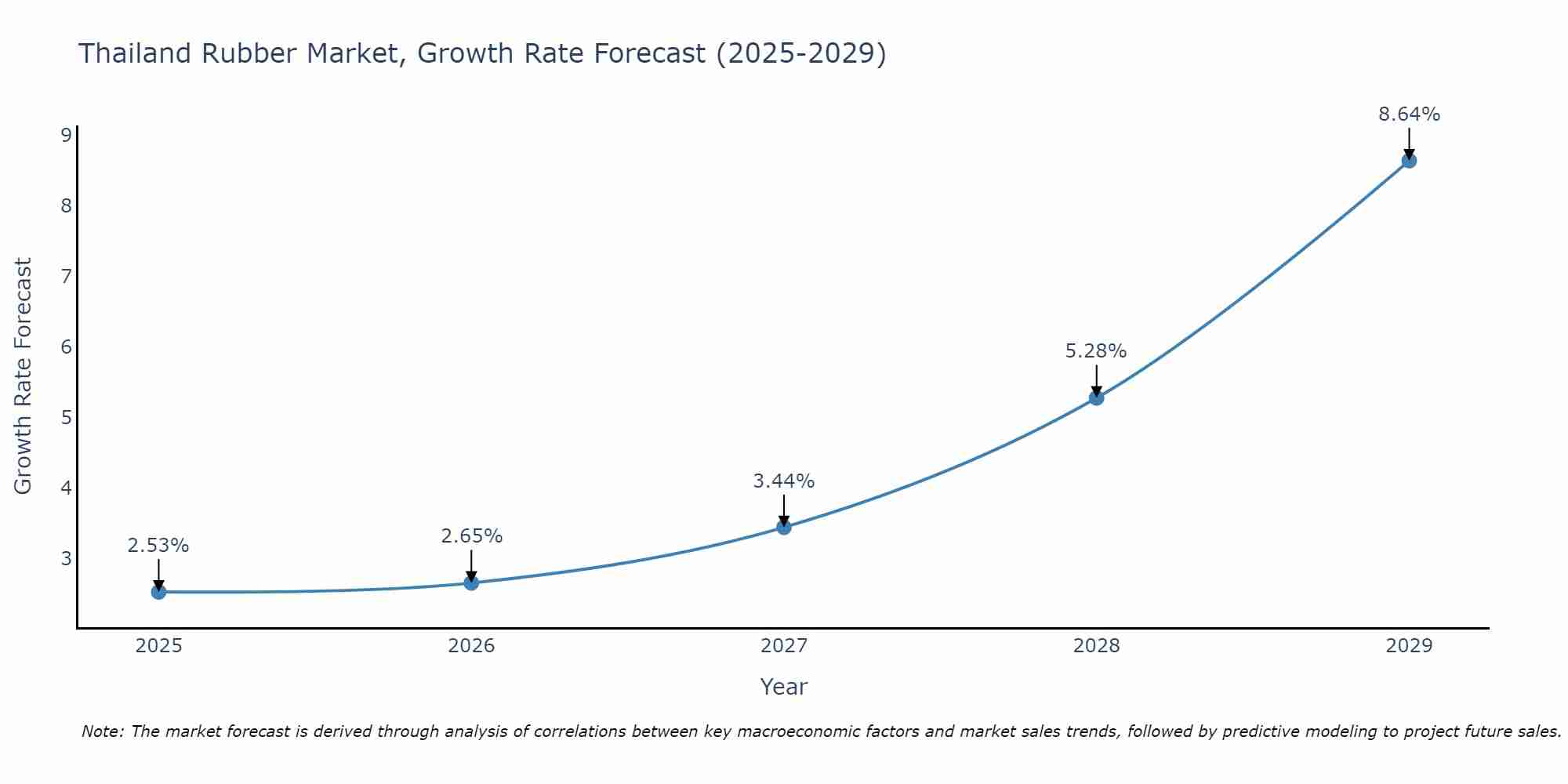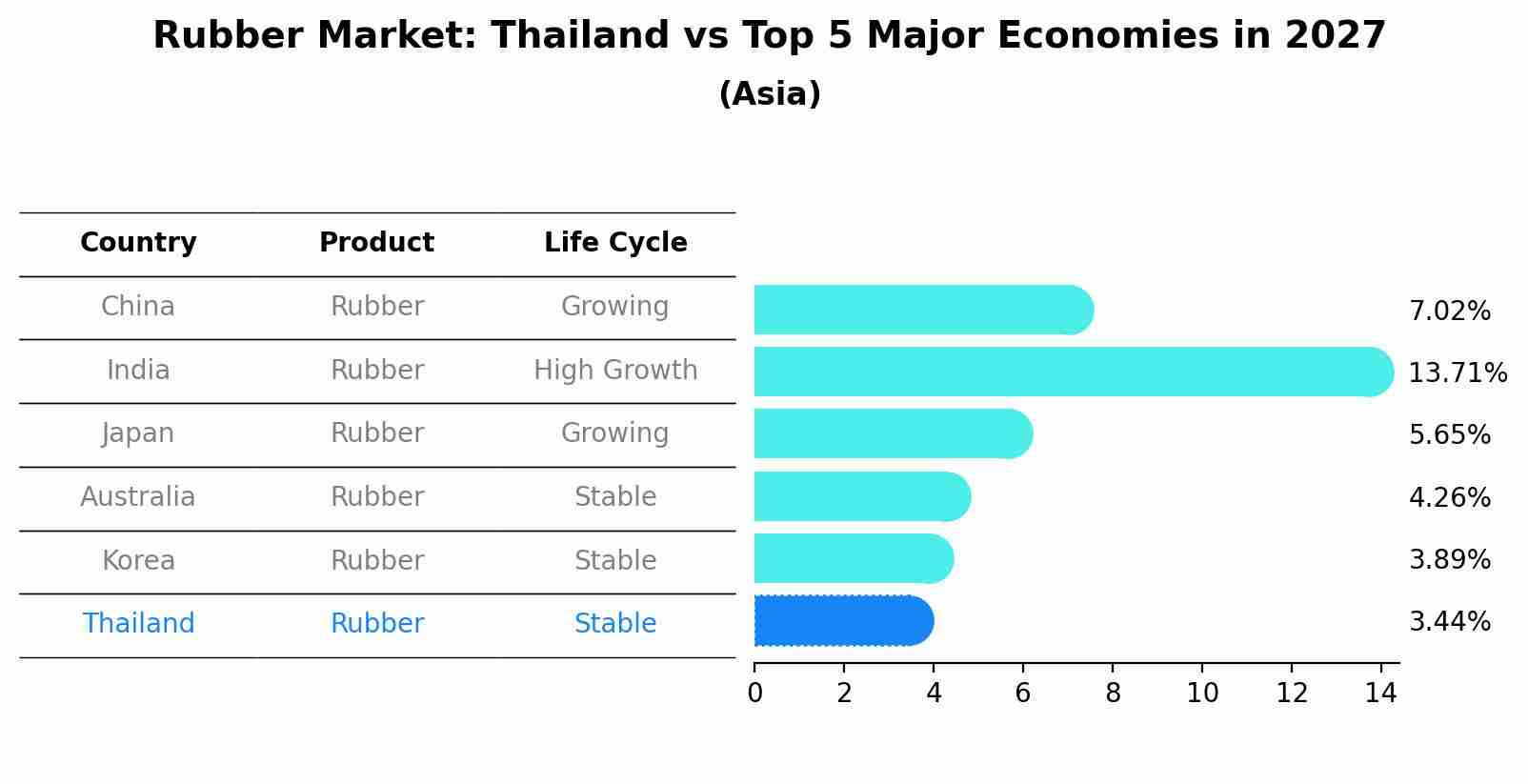Thailand Rubber Market | Analysis, Trends, Revenue, Outlook, Growth, Industry, COVID-19 IMPACT, Size, Value, Companies, Forecast & Share
| Product Code: ETC172424 | Publication Date: Jan 2022 | Updated Date: Apr 2025 | Product Type: Market Research Report | |
| Publisher: 6Wresearch | No. of Pages: 70 | No. of Figures: 35 | No. of Tables: 5 | |
Thailand Rubber Market Size Growth Rate
The Thailand Rubber Market is poised for steady growth rate improvements from 2025 to 2029. From 2.53% in 2025, the growth rate steadily ascends to 8.64% in 2029.

Rubber Market: Thailand vs Top 5 Major Economies in 2027 (Asia)
Thailand's Rubber market is anticipated to experience a stable growth rate of 3.44% by 2027, reflecting trends observed in the largest economy China, followed by India, Japan, Australia and South Korea.

Thailand Rubber Market Synopsis
The Thailand rubber industry is estimated to be worth about USD 5.2 billion in 2020 and is expected to register a compound annual growth rate (CAGR) of around 6.9% over the forecast period. The industry includes both natural and synthetic rubbers, with the latter accounting for almost 75% of the total revenue generated by the sector in 2019. The country?s imports are majorly derived from Malaysia, China, Japan, Singapore and Vietnam while its exports are mainly directed towards India, China and Sri Lanka.
Drivers of the Market
In the Thailand rubber market, several factors are driving its growth. Firstly, rubber is a vital raw material used in various industries, including automotive, manufacturing, construction, and healthcare. The expansion of these sectors contributes to the demand for rubber products such as tires, hoses, belts, seals, and medical equipment. Moreover, the trend of sustainable and eco-friendly practices encourages the use of natural rubber over synthetic alternatives, benefiting rubber producers. Additionally, Thailandgeographical advantage of being a major rubber-producing country ensures a steady supply of raw materials for domestic and international markets. The government`s support for the rubber industry through research, development, and innovation further strengthens the position of Thailand in the global rubber market.
Challenges of the Market
The Thailand rubber market grapples with challenges associated with global demand and sustainability. While rubber is a crucial export commodity, the industry has faced issues related to deforestation, land use conflicts, and fair wages for rubber plantation workers. Addressing these challenges requires sustainable cultivation practices, responsible land use, and initiatives that prioritize the well-being of workers and local communities.
COVID-19 Impact on the Market
In the Thailand rubber market, the COVID-19 pandemic influenced the rubber industry`s supply chain and demand dynamics. Lockdowns and restrictions affected industrial production and transportation, leading to reduced demand for rubber from industries such as automotive and manufacturing. Export-oriented segments faced challenges due to disruptions in global trade and logistics. Additionally, rubber plantations faced labor shortages and fluctuations in commodity prices. Some players in the industry explored innovative applications for rubber products, such as personal protective equipment. The market`s recovery hinged on the revival of industries that rely on rubber, as well as adaptation to changing consumer and industrial needs.
Key Players in the Market
In the Thailand rubber market, noteworthy players such as RubberTech Industries, ThaiRubber Corporation, and EcoRubber Innovations have made their mark. These companies have been involved in producing and supplying rubber materials used in various industries including automotive, construction, and manufacturing. Their contributions to providing essential raw materials and supporting diverse applications underscore their significance in industrial sectors.
Key Highlights of the Report:
- Thailand Rubber Market Outlook
- Market Size of Thailand Rubber Market, 2023
- Forecast of Thailand Rubber Market, 2030
- Historical Data and Forecast of Thailand Rubber Revenues & Volume for the Period 2020-2030
- Thailand Rubber Market Trend Evolution
- Thailand Rubber Market Drivers and Challenges
- Thailand Rubber Price Trends
- Thailand Rubber Porter's Five Forces
- Thailand Rubber Industry Life Cycle
- Historical Data and Forecast of Thailand Rubber Market Revenues & Volume By Type for the Period 2020-2030
- Historical Data and Forecast of Thailand Rubber Market Revenues & Volume By Natural for the Period 2020-2030
- Historical Data and Forecast of Thailand Rubber Market Revenues & Volume By Synthetic for the Period 2020-2030
- Historical Data and Forecast of Thailand Rubber Market Revenues & Volume By Application for the Period 2020-2030
- Historical Data and Forecast of Thailand Rubber Market Revenues & Volume By Tire for the Period 2020-2030
- Historical Data and Forecast of Thailand Rubber Market Revenues & Volume By Non-Tire Automotive for the Period 2020-2030
- Historical Data and Forecast of Thailand Rubber Market Revenues & Volume By Footwear for the Period 2020-2030
- Historical Data and Forecast of Thailand Rubber Market Revenues & Volume By Industrial Goods for the Period 2020-2030
- Historical Data and Forecast of Thailand Rubber Market Revenues & Volume By Others for the Period 2020-2030
- Thailand Rubber Import Export Trade Statistics
- Market Opportunity Assessment By Type
- Market Opportunity Assessment By Application
- Thailand Rubber Top Companies Market Share
- Thailand Rubber Competitive Benchmarking By Technical and Operational Parameters
- Thailand Rubber Company Profiles
- Thailand Rubber Key Strategic Recommendations
Frequently Asked Questions About the Market Study (FAQs):
1 Executive Summary |
2 Introduction |
2.1 Key Highlights of the Report |
2.2 Report Description |
2.3 Market Scope & Segmentation |
2.4 Research Methodology |
2.5 Assumptions |
3 Thailand Rubber Market Overview |
3.1 Thailand Country Macro Economic Indicators |
3.2 Thailand Rubber Market Revenues & Volume, 2020 & 2030F |
3.3 Thailand Rubber Market - Industry Life Cycle |
3.4 Thailand Rubber Market - Porter's Five Forces |
3.5 Thailand Rubber Market Revenues & Volume Share, By Type, 2020 & 2030F |
3.6 Thailand Rubber Market Revenues & Volume Share, By Application, 2020 & 2030F |
4 Thailand Rubber Market Dynamics |
4.1 Impact Analysis |
4.2 Market Drivers |
4.3 Market Restraints |
5 Thailand Rubber Market Trends |
6 Thailand Rubber Market, By Types |
6.1 Thailand Rubber Market, By Type |
6.1.1 Overview and Analysis |
6.1.2 Thailand Rubber Market Revenues & Volume, By Type, 2020-2030F |
6.1.3 Thailand Rubber Market Revenues & Volume, By Natural, 2020-2030F |
6.1.4 Thailand Rubber Market Revenues & Volume, By Synthetic, 2020-2030F |
6.2 Thailand Rubber Market, By Application |
6.2.1 Overview and Analysis |
6.2.2 Thailand Rubber Market Revenues & Volume, By Tire, 2020-2030F |
6.2.3 Thailand Rubber Market Revenues & Volume, By Non-Tire Automotive, 2020-2030F |
6.2.4 Thailand Rubber Market Revenues & Volume, By Footwear, 2020-2030F |
6.2.5 Thailand Rubber Market Revenues & Volume, By Industrial Goods, 2020-2030F |
6.2.6 Thailand Rubber Market Revenues & Volume, By Others, 2020-2030F |
7 Thailand Rubber Market Import-Export Trade Statistics |
7.1 Thailand Rubber Market Export to Major Countries |
7.2 Thailand Rubber Market Imports from Major Countries |
8 Thailand Rubber Market Key Performance Indicators |
9 Thailand Rubber Market - Opportunity Assessment |
9.1 Thailand Rubber Market Opportunity Assessment, By Type, 2020 & 2030F |
9.2 Thailand Rubber Market Opportunity Assessment, By Application, 2020 & 2030F |
10 Thailand Rubber Market - Competitive Landscape |
10.1 Thailand Rubber Market Revenue Share, By Companies, 2023 |
10.2 Thailand Rubber Market Competitive Benchmarking, By Operating and Technical Parameters |
11 Company Profiles |
12 Recommendations |
13 Disclaimer |
- Single User License$ 1,995
- Department License$ 2,400
- Site License$ 3,120
- Global License$ 3,795
Search
Related Reports
- Saudi Arabia Manlift Market (2025-2031) | Outlook, Size, Growth, Trends, Companies, Industry, Revenue, Value, Share, Forecast & Analysis
- Uganda Excavator, Crane, and Wheel Loaders Market (2025-2029) | Strategy, Consumer Insights, Analysis, Investment Trends, Opportunities, Growth, Size, Share, Industry, Revenue, Segments, Value, Segmentation, Supply, Forecast, Restraints, Outlook, Competition, Drivers, Trends, Demand, Pricing Analysis, Competitive, Strategic Insights, Companies, Challenges
- Rwanda Excavator, Crane, and Wheel Loaders Market (2025-2031) | Strategy, Consumer Insights, Analysis, Investment Trends, Opportunities, Growth, Size, Share, Industry, Revenue, Segments, Value, Segmentation, Supply, Forecast, Restraints, Outlook, Competition, Drivers, Trends, Demand, Pricing Analysis, Competitive, Strategic Insights, Companies, Challenges
- Kenya Excavator, Crane, and Wheel Loaders Market (2025-2031) | Strategy, Consumer Insights, Analysis, Investment Trends, Opportunities, Growth, Size, Share, Industry, Revenue, Segments, Value, Segmentation, Supply, Forecast, Restraints, Outlook, Competition, Drivers, Trends, Demand, Pricing Analysis, Competitive, Strategic Insights, Companies, Challenges
- Angola Excavator, Crane, and Wheel Loaders Market (2025-2031) | Strategy, Consumer Insights, Analysis, Investment Trends, Opportunities, Growth, Size, Share, Industry, Revenue, Segments, Value, Segmentation, Supply, Forecast, Restraints, Outlook, Competition, Drivers, Trends, Demand, Pricing Analysis, Competitive, Strategic Insights, Companies, Challenges
- Israel Intelligent Transport System Market (2025-2031) | Strategy, Consumer Insights, Analysis, Investment Trends, Opportunities, Growth, Size, Share, Industry, Revenue, Segments, Value, Segmentation, Supply, Forecast, Restraints, Outlook, Competition, Drivers, Trends, Demand, Pricing Analysis, Competitive, Strategic Insights, Companies, Challenges
- Uganda Precast and Aggregate Market (2025-2031) | Strategy, Consumer Insights, Analysis, Investment Trends, Opportunities, Growth, Size, Share, Industry, Revenue, Segments, Value, Segmentation, Supply, Forecast, Restraints, Outlook, Competition, Drivers, Trends, Demand, Pricing Analysis, Competitive, Strategic Insights, Companies, Challenges
- Australia IT Asset Disposal Market (2025-2031) | Strategy, Consumer Insights, Analysis, Investment Trends, Opportunities, Growth, Size, Share, Industry, Revenue, Segments, Value, Segmentation, Supply, Forecast, Restraints, Outlook, Competition, Drivers, Trends, Demand, Pricing Analysis, Competitive, Strategic Insights, Companies, Challenges
- UAE Building Thermal Insulation Market Outlook (2025-2031) | Revenue, Companies, Share, Trends, Growth, Size, Forecast, Industry, Analysis & Value
- Portugal Electronic Document Management Market (2025-2031) | Strategy, Consumer Insights, Analysis, Investment Trends, Opportunities, Growth, Size, Share, Industry, Revenue, Segments, Value, Segmentation, Supply, Forecast, Restraints, Outlook, Competition, Drivers, Trends, Demand, Pricing Analysis, Competitive, Strategic Insights, Companies, Challenges
Industry Events and Analyst Meet
Our Clients
Whitepaper
- Middle East & Africa Commercial Security Market Click here to view more.
- Middle East & Africa Fire Safety Systems & Equipment Market Click here to view more.
- GCC Drone Market Click here to view more.
- Middle East Lighting Fixture Market Click here to view more.
- GCC Physical & Perimeter Security Market Click here to view more.
6WResearch In News
- Doha a strategic location for EV manufacturing hub: IPA Qatar
- Demand for luxury TVs surging in the GCC, says Samsung
- Empowering Growth: The Thriving Journey of Bangladesh’s Cable Industry
- Demand for luxury TVs surging in the GCC, says Samsung
- Video call with a traditional healer? Once unthinkable, it’s now common in South Africa
- Intelligent Buildings To Smooth GCC’s Path To Net Zero













